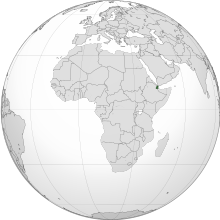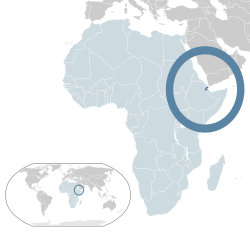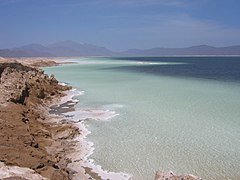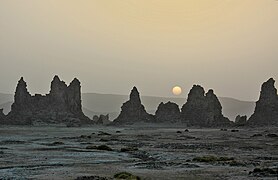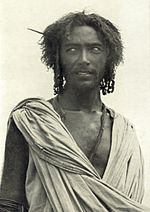Djibouti
This article has multiple issues.Please helpimprove itor discuss these issues on thetalk page.(Learn how and when to remove these template messages)
|
Republic of Djibouti | |
|---|---|
| Motto: Midnimo, Sinnaan, Nabad(Somali) Inkittiino, Qeedala, Wagari(Afar) Unité, Égalité, Paix(French) اتحاد، مساواة، سلام(Arabic) Unity, Equality, Peace(English) | |
| Anthem:Djibouti | |
| Capital and largest city | Djibouti 11°36′N43°10′E/ 11.600°N 43.167°E |
| Official languages | |
| National languages | |
| Ethnic groups | |
| Religion | 94%Islam(official) 6%Christianity |
| Demonym(s) | Djiboutian |
| Government | Unitarypresidential republicunder adictatorship[2][3][4] |
| Ismaïl Omar Guelleh | |
| Abdoulkader Kamil Mohamed | |
| Legislature | National Assembly |
| Formation | |
| 20 May 1883 | |
| 5 July 1967 | |
• Independence fromFrance | 27 June 1977 |
| 20 September 1977 | |
| 4 September 1992 | |
| Area | |
• Total | 23,200[1]km2(8,958 sq mi)[1](146th) |
• Water (%) | 0.09 (20 km² / 7.7 sq mi) |
| Population | |
• 2023 estimate | 976,143[5](162th) |
• Density | 37.2/km2(96.3/sq mi) (168th) |
| GDP(PPP) | 2023 estimate |
• Total | |
• Per capita | |
| GDP(nominal) | 2023 estimate |
• Total | |
• Per capita | |
| Gini(2017) | medium |
| HDI(2021) | low(171st) |
| Currency | Djiboutian franc(DJF) |
| Time zone | UTC+3(EAT) |
| Driving side | right |
| Calling code | +253 |
| ISO 3166 code | DJ |
| Internet TLD | .dj |
Djibouti,[a]officially theRepublic of Djibouti,[b]is a country in theHorn of Africa,bordered bySomalia[c]to the south,Ethiopiato the southwest,Eritreain the north, and theRed Seaand theGulf of Adento the east. The country has an area of 23,200 km2(8,958 sq mi).[1]
In antiquity, the territory, together with Ethiopia, Eritrea and Somaliland, was part of theLand of Punt.NearbyZeila,now in Somaliland, was the seat of the medievalAdalandIfatSultanates. In the late 19th century, the colony ofFrench Somalilandwas established after the rulingDirSomalisultans signed treaties with the French,[11][12][13]and itsrailroadtoDire Dawa(and laterAddis Ababa) allowed it to quickly supersedeZeilaas the port for southernEthiopiaand theOgaden.[14]It was renamed theFrench Territory of the Afars and the Issasin 1967. A decade later, the Djiboutian peoplevoted for independence.This officially marked the establishment of theRepublic of Djibouti,named after itscapital city.The new state joined the United Nations in its first year.[15][16]In the early 1990s, tensions over government representation led toarmed conflict,which ended in a power-sharing agreement in 2000 between the ruling party and the opposition.[1]
Djibouti is a multi-ethnic nation with a population of over 920,000 (the smallestin mainland Africa). French and Arabic are its two official languages, Afar and Somali are national languages. About 94% of Djiboutians adhere toIslam,[1]which is the official religion and has been predominant in the region for more than 1,000 years. TheSomalisandAfarmake up the two largest ethnic groups, with the former comprising the majority of the population. Both speak a language of theCushiticbranch of theAfroasiatic languages.[1]
Djibouti is near some of the world's busiest shipping lanes, controlling access to theRed SeaandIndian Ocean.It serves as a key refuelling and transshipment center, and the principal maritime port for imports from and exports to neighboringEthiopia.A burgeoning commercial hub, the nation is the site of various foreign military bases. TheIntergovernmental Authority on Development(IGAD) regional body also has its headquarters in Djibouti City.[1]
Name and etymology
Djiboutiis officially known as theRepublic of Djibouti.In local languages it is known asYibuuti(inAfar) andJabuuti(inSomali).
The country is named for its capital, theCity of Djibouti.The etymology of the name is disputed. There are several theories and legends about its origin, varying based on ethnicity. One theory derives it from theAfarwordgabouti,meaning "plate", possibly referring to the area's geographical features.[17]Another connects it togabood,meaning "upland/plateau".[18]Djibouti could also mean "Land ofTehuti"or" Land ofThoth(Egyptian:Djehuti/Djehuty) ", after theEgyptianmoon god.[19][20]
From 1862 until 1894, the land to the north of theGulf of Tadjourawas called "Obock".Under French administration, from 1883 to 1967 the area was known asFrench Somaliland(French:Côte française des Somalis), and from 1967 to 1977 as theFrench Territory of the Afars and the Issas(French:Territoire français des Afars et des Issas).
History
This sectionneeds additional citations forverification.(November 2023) |
Prehistory

TheBab-el-Mandebregion has often been considered a primary crossing point for early hominins following a southern coastal route fromEast AfricatoSouthandSoutheast Asia.
The Djibouti area has been inhabited since theNeolithic.According to linguists, the firstAfroasiatic-speaking populations arrived in the region during this period from the family's proposedurheimat( "original homeland" ) in theNile Valley,[21]or theNear East.[22]Other scholars propose that the Afroasiatic family developed in situ in the Horn, with its speakers subsequently dispersing from there.[23]
Cut stones dated about 3 million years old have been collected in the area ofLake Abbe.[citation needed]In the Gobaad plain (between Dikhil and Lake Abbe), the remains of the extinct elephantPalaeoloxodon reckiwere also discovered, visibly butchered using basalt tools found nearby. These remains would date from 1.4 million years BCE. Subsequently, other similar sites were identified as probably the work ofHomo ergaster.AnAcheuleansite (from 800,000 to 400,000 years BCE), wherestonewas cut, was excavated in the 1990s, in Gombourta, betweenDamerdjogandLoyada,15 km south ofDjibouti City.Finally, in Gobaad, aHomo erectusjaw was found, dating from 100,000 BCE. OnDevil's Island,tools dating back 6,000 years have been found, which were used to open shells. In the area at the bottom ofGoubet(Dankalélo, not far from Devil's Island), circular stone structures and fragments of paintedpotteryhave also been discovered. Previous investigators have also reported a fragmentary maxilla, attributed to an older form ofHomo sapiensand dated to c. 250 Ka, from the valley of the Dagadlé Wadi.[citation needed]

Pottery predating the mid-2nd millennium has been found atAsa Koma,an inland lake area on the Gobaad Plain. The site's ware is characterized by punctate and incision geometric designs, which bear a similarity to the Sabir culture phase 1 ceramics from Ma'layba inSouthern Arabia.[24]Long-horned humpless cattle bones have likewise been discovered at Asa Koma, suggesting that domesticated cattle were present by around 3,500 years ago.[25]Rock art of what appear to be antelopes and a giraffe are also found atDorraandBalho.[26]Handoga,dated to the fourth millennium BCE, has in turn yielded obsidian microliths and plain ceramics used by early nomadic pastoralists with domesticated cattle.[27]
The site of Wakrita is a smallNeolithicestablishment located on awadiin the tectonic depression of Gobaad in Djibouti in theHorn of Africa.The 2005 excavations[citation needed]yielded abundant ceramics that enabled us to define one Neolithic cultural facies of thisregion,which was also identified at the nearby site ofAsa Koma.The faunal remains confirm the importance of fishing in Neolithic settlements close toLake Abbé,but also the importance of bovine husbandry and, for the first time in this area, evidence for caprine herding practices. Radiocarbon dating places this occupation at the beginning of the 2nd millennium BCE, similar in range to Asa Koma. These two sites represent the oldest evidence of herding in the region, and they provide a better understanding of the development of Neolithic societies in this region.
Up to 4000 years BCE, the region benefited from a climate very different from the one it knows today and probably close to theMediterranean climate.The water resources were numerous with lakes in Gobaad, lakes Assal and Abbé larger and resembling real bodies of water. The humans therefore lived by gathering, fishing and hunting. The region was populated by a very rich fauna:felines,buffaloes,elephants,rhinos,etc., as evidenced, for example, by the bestiary of cave paintings atBalho.In the 3rd and 2nd millennia BCE, few nomads settled around the lakes and practiced fishing and cattle breeding. The burial of an 18-year-old woman, dating from this period, as well as the bones of hunted animals, bone tools and smalljewelshave been unearthed. By about 1500 BCE, the climate was already beginning to change, with sources of fresh water becoming more scarce. Engravings show dromedaries (animal of arid zones), some of which are ridden by armed warriors. The sedentary people now returned to a nomadic life. Stonetumuliof various shapes and sheltering graves dating from this period have been unearthed all over the territory.
Punt (2,500 BCE)

Together with northern Ethiopia, Somaliland, Eritrea and the Red Sea coast of Sudan, Djibouti is considered the most likely location of the territory known to theAncient EgyptiansasPunt(orTa Netjeru,meaning "God's Land" ). The first mention of the Land of Punt dates to the 25th century BC.[28]The Puntites were a nation of people who had close relations with Ancient Egypt during the reign of the 5th dynasty PharaohSahureand the 18th dynasty QueenHatshepsut.[29]According to the temple murals atDeir el-Bahari,the Land of Punt was ruled at that time by King Parahu and Queen Ati.[30]
Adal (900–1285)
TheAdal(alsoAwdal,Adl,orAdel)[31]was centered aroundZeila,its capital.[32][33][34]It was established by the localSomalitribes in the early 9th century. Zeila attracted merchants from around the world, contributing to the wealth of the city. Zeila is an ancient city and it was one of the earliest cities in the world to embraceIslam,shortly after thehijra.Zeila's two-mihrabMasjid al-Qiblatayndates to the 7th century, and is the oldest mosque.[35][36][31][37]
In the late 9th century,Al-Yaqubi,an Arab Muslim scholar and traveler, wrote that the Kingdom of Adal was a small wealthy kingdom and that Zeila served as the headquarters for the kingdom, which dated back to the beginning of the century.[38][39]
Ifat Sultanate (1285–1415)
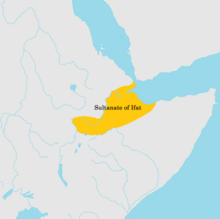
Through close contacts with the adjacent Arabian Peninsula for more than 1,000 years, the Somali and Afar ethnic groups in the region became among the first populations on the continent to embrace Islam.[40]TheIfat Sultanatewas a Muslim medieval kingdom in theHorn of Africa.Founded in 1285 by theWalashma dynasty,it was centered in Zeila.[41][42]Ifat established bases in Djibouti and Somaliland, and from there expanded southward to theAhmar Mountains.ItsSultanUmar Walashma (or his son Ali, according to another source) is recorded as having conquered theSultanate of Shewain 1285. Taddesse Tamrat explains Sultan Umar's military expedition as an effort to consolidate the Muslim territories in the Horn, in much the same way as EmperorYekuno Amlakwas attempting to unite the Christian territories in the highlands during the same period. These two states inevitably came into conflict over Shewa and territories further south. A lengthy war ensued, but the Muslim sultanates of the time were not strongly unified. Ifat was finally defeated by EmperorAmda Seyon Iof Ethiopia in 1332, and withdrew from Shewa.
Adal Sultanate (1415–1577)

According to the 16th-century explorerLeo Africanus,the Adal Sultanate's realm encompassed the geographical area between theBab el MandebandCape Guardafui.It was therefore flanked to the south by theAjuran Empire(Kingdom of Ajuuran) and to the west by theAbyssinian Empire(Abassin Empire).[43][44]Adal is mentioned by name in the 14th century in the context of the battles between the Muslims of the Somali and Afar seaboard and the Abyssinian KingAmda Seyon I'sChristiantroops.[45]Adal originally had its capital in the port city of Zeila, situated in the western Awdal region. The polity at the time was anEmiratein the largerIfat Sultanateruled by theWalashma dynasty.[46] According to I.M. Lewis, the polity was governed by local dynasties consisting of Afarized Arabs or Arabized Somalis, who also ruled over the similarly establishedSultanate of Mogadishuin theBenadirregion to the south. Adal's history from this founding period forth would be characterized by a succession of battles with neighbouringAbyssinia.[39]At its height, the Adal kingdom controlled large parts of modern-day Djibouti,Somaliland,Eritreaand Ethiopia. BetweenDjibouti CityandLoyadaare a number of anthropomorphic and phallicstelae.The structures are associated with graves of rectangular shape flanked by vertical slabs, as also found inTiya,centralEthiopia.The Djibouti-Loyada stelae are of uncertain age, and some of them are adorned with a T-shaped symbol.[47]Additionally, archaeological excavations at Tiya have yielded tombs.[48]As of 1997, 118 stelae were reported in the area. Along with the stelae in theHadiya Zone,the structures are identified by local residents asYegragn Dingayor "Gran's stone", in reference to ImamAhmad ibn Ibrahim al-Ghazi(Ahmad "Gurey" or "Gran" ), ruler of theAdal Sultanate.[49]
Ottoman Eyalet (1577–1867)

Although nominally part of theOttoman Empiresince 1577, between 1821 and 1841,Muhammad Ali,Pasha ofEgypt,came to controlYemen,Harar,Gulf of TadjourawithZeilaandBerberaincluded. The Governor Abou Baker ordered the Egyptian garrison atSagalloto retire toZeila.The cruiser Seignelay reached Sagallo shortly after the Egyptians had departed. French troops occupied the fort despite protests from the British Agent inAden,Major Frederick Mercer Hunter, who dispatched troops to safeguard British and Egyptian interests inZeilaand prevent further extension of French influence in that direction.[50]
On 14 April 1884 the Commander of the patrol sloop L'Inferent reported on the Egyptian occupation in the Gulf of Tadjoura. The Commander of the patrol sloop Le Vaudreuil reported that the Egyptians were occupying the interior betweenObockandTadjoura.EmperorYohannes IVof Ethiopia signed an accord with Great Britain to cease fighting the Egyptians and to allow the evacuation of Egyptian forces fromEthiopiaand the Somaliland littoral. The Egyptian garrison was withdrawn fromTadjoura.Léonce Lagarde deployed a patrol sloop toTadjourathe following night.
French rule (1883–1977)
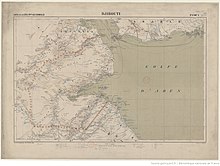
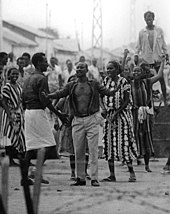
The boundaries of the present-day Djibouti state were established as the first French establishment in theHorn of Africaduring theScramble for Africa.The March 11, 1862, agreement theAfarsultan,Raieta Dini Ahmet, signed inPariswas a treaty where the Afars sold lands surrounding inObock.The French were interested in having acoaling stationforsteamships,which would become especially important upon the opening of theSuez Canalin 1869. (Up to that time French ships had to buy coal at the British port ofAdenacross the gulf, an unwise dependency in case of war.) Later on, that treaty was used by the captain of the Fleuriot de Langle to colonize the south of theGulf of Tadjoura.[51]On March 26, 1885, the French signed another treaty with the Issas where the latter would become a protectorate under the French, no monetary exchange occurred andIssa clandid not sign away any of their rights to the land, the agreement was to kick the Gadebuursi, who were against the French, and the Isaaq from the country with the help of the French.[52][53][54]It was established between 1883 and 1887, after the rulingSomalisandAfarsultans each signed a treaty with theFrench.[55][11][13]An attempt byNikolay Ivanovitch Achinov,aRussianadventurer, to establish a settlement atSagalloin 1889 was promptly thwarted by French forces after just one month. In 1894,Léonce Lagardeestablished a permanent French administration in thecity of Djiboutiand named the regionFrench Somaliland.As is shown in "Morin" (2005), this name has been proposed by Mohamed Haji Dide of the Mahad 'Ase branch of theGadabuursi.It lasted from 1896 until 1967, when it was renamed theTerritoire Français des Afars et des Issas(TFAI) ( "French Territory of the Afars and the Issas"), after France, the colonial power, has empowered the Issas clan at the expense of theGadabuursi. The construction of theImperial Ethiopian Railwaywest intoEthiopiaturned theport of Djiboutiinto a boomtown of 15,000[56]at a time whenHararwas the only city in Ethiopia to exceed that.[57]

Although the population fell after the completion of the railwayline toDire Dawaand the original company failed and required a government bail-out, the rail link allowed the territory to quickly supersede the caravan-based trade carried on atZeila[58](then in theBritisharea ofSomaliland) and become the premier port forcoffeeand other goods leaving southern Ethiopia and theOgadenthroughHarar.
After the Italianinvasion and occupation of Ethiopiain the mid-1930s, constant border skirmishes occurred between French forces in French Somaliland and Italian forces inItalian East Africa.In June 1940, during the early stages ofWorld War II,France felland the colony was then ruled by the pro-AxisVichy (French) government.[59]
British and Commonwealth forces fought the neighboring Italians during theEast African Campaign.In 1941, the Italians were defeated and the Vichy forces in French Somaliland were isolated. The Vichy French administration continued to hold out in the colony for over a year after the Italian collapse. In response, the British blockaded the port ofDjibouti Citybut it could not prevent local French from providing information on the passing ship convoys. In 1942, about 4,000British troopsoccupied the city. A local battalion from French Somaliland participated in theLiberation of Parisin 1944.[60]
In 1958, on the eve of neighboring Somalia's independence in 1960, areferendumwas held in Djibouti to decide whether to remain with France or to be an independent country. The referendum turned out in favour of a continued association with France, partly due to a combined yes vote by the sizable Afar ethnic group and resident French.[61]There were also allegations of widespreadvote rigging.[62]The majority of those who had voted no were Somalis who were strongly in favour of joining a united Somalia as had been proposed byMahmoud Harbi,Vice President of the Government Council. Harbi was killed in a plane crash two years later under suspicious circumstances.[61]

In 1966, France rejected theUnited Nations' recommendation that it should grant French Somaliland independence. In August of the same year, an official visit to the territory by then French PresidentCharles de Gaulle,was also met with demonstrations and rioting.[13][63]In response to the protests, de Gaulle ordered another referendum.[63]
In 1967, asecond plebiscitewas held to determine the fate of the territory. Initial results supported a continued but looser relationship with France. Voting was also divided along ethnic lines, with the resident Somalis generally voting for independence, with the goal of eventual union with Somalia, and the Afars largely opting to remain associated with France.[13]The referendum was again marred by reports of vote rigging on the part of the French authorities.[64]Shortly after the plebiscite was held, the formerCôte française des Somalis(French Somaliland) was renamed toTerritoire français des Afars et des Issas.[65]Announcement of the plebiscite results sparked civil unrest, including several deaths. France also increased its military force along the frontier.[65]
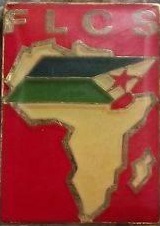
During the 1960s, the struggle for independence was led by theFront for the Liberation of the Somali Coast(FLCS), who waged an armed struggle for independence with much of its violence aimed at French personnel. FLCS used to initiate few mounting cross-border operations intoFrench SomalilandfromSomaliaandEthiopiato attacks on French targets. On March 24, 1975, the Front de Libération de la Côte des Somalis kidnapped the French Ambassador to Somalia, Jean Guery, to be exchanged against two activists of FLCS members who were both serving life terms in mainlandFrance.He was exchanged for the two FLCS members inAden,South Yemen.[66]The FLCS was recognized as a national liberation movement by theOrganization of African Unity(OAU), which participated in its financing. The FLCS evolved its demands between the request of integration in a possible "Greater Somalia"influenced by theSomali governmentor the simple independence of the territory. In 1975 the African People's League for the Independence (LPAI) and FLCS met inKampala,Ugandawith several meeting later they finally opted for independence path, causing tensions withSomalia.[67]
In 1976, members of theFront de Libération de la Côte des Somaliswhich sought Djibouti's independence fromFrance,also clashed with the Gendarmerie Nationale Intervention Group over a bus hijacking en route toLoyada.This event, by showing the difficulties of maintaining the French colonial presence in Djibouti, was an important step in theindependenceof theterritory.The likelihood of a thirdreferendumappearing successful for the French had grown even dimmer. The prohibitive cost of maintaining thecolony,France's last outpost on thecontinent,was another factor that compelled observers to doubt that theFrenchwould attempt to hold on to the territory.[63][68]
Djibouti Republic
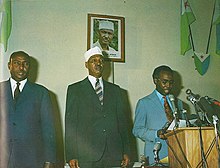
Athird independence referendumwas held in theFrench Territory of the Afars and the Issason 8 May 1977. The previous referendums were held in1958and1967,[69][64]which rejectedindependence.This referendum backed independence fromFrance.[70]A landslide 98.8% of the electorate supported disengagement from France, officially markingDjibouti's independence.[63]Hassan Gouled Aptidon,an Issa (ethnic Somali) politician who had campaigned for a yes vote in the referendum of 1958, became the nation's first president (1977–1999).[61]
During its first year, Djibouti joined theOrganization of African Unity(now theAfrican Union), theArab League,and the United Nations. In 1986, the nascent republic was also among the founding members of theIntergovernmental Authority on Developmentregional development organization. During theOgaden War,influential Issa politicians envisioned a Greater Djibouti or "Issa-land", where Djibouti's borders would extend from the Red Sea toDire Dawa.[71]That dream was dashed towards the end of the war as Somali forces were routed from Ethiopia.[71]
In the early 1990s, tensions over government representation led toarmed conflictbetween Djibouti's rulingPeople's Rally for Progress(PRP) party and theFront for the Restoration of Unity and Democracy(FRUD) opposition group. The impasse ended in a power-sharing agreement in 2000.[1]
In April 2021,Ismael Guelleh,the secondPresident of Djiboutisince independence from France in 1977, wasre-electedfor his fifth term.[72]
Politics
Djibouti is aunitarypresidentialrepublic,withexecutive powerresting in the presidency, which is by turn dominant over the cabinet, andlegislative powerin both the government and theNational Assembly.
Governance
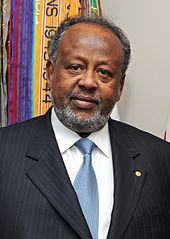
Thepresident,Ismaïl Omar Guelleh,is the prominent figure in Djiboutian politics—thehead of stateandcommander-in-chief.The president exercises their executive power assisted by their appointee, thePrime Minister,Abdoulkader Kamil Mohamed.The Council of Ministers (cabinet) is responsible to and presided over by the president.
The judicial system consists of courts of first instance, a High Court of Appeal, and a Supreme Court. Thelegal systemis a blend ofFrench civil lawandcustomary law(Xeer) of the Somali and Afar peoples.[73][74]
The National Assembly (formerly theChamber of Deputies) is the country's legislature,[73][74]consisting of 65 members elected every five years.[75]Althoughunicameral,the Constitution provides for the creation of a Senate.[73][74] Thelast electionwas held on 23 February 2018. Djibouti has adominant-party system,with thePeople's Rally for Progress(RPP) controlling the legislature and the executive since its foundation in 1979 (the party rules as a part of theUnion for a Presidential Majority,which holds asupermajorityof seats). Opposition parties are allowed (limited) freedom, but the main opposition party, theUnion for National Salvation,boycotted the 2005 and 2008 elections, citing government control of the media and repression of the opposition candidates.[75]
The government is dominated by the SomaliIssaDirclan, who have the support of theSomali clans,especially theGadabuursiDirclan. The country emerged from a decade-longcivil warat the end of the 1990s with the government and theFront for the Restoration of Unity and Democracy(FRUD) signing a peace treaty in 2000. Two FRUD members joined the cabinet,[1]and beginning withthe presidential elections of 1999,the FRUD has campaigned in support of the RPP.
President Guelleh succeededHassan Gouled Aptidonin office in 1999.[76]Guelleh was sworn in for his second six-year term after aone-man electionon 8 April 2005. He took 100% of the votes in a 78.9% turnout.[76]In early 2011, the Djiboutian citizenry took part in aseries of protestsagainst the long-serving government, which were associated with the largerArab Springdemonstrations. Guelleh wasreelectedto a third term later that year with 80.63% of the vote in a 75% turnout.[77]Although opposition groups boycotted the ballot over changes to the constitution permitting Guelleh to run again for office,[77]international observers from the African Union generally described the election as free and fair.[78][79]
On 31 March 2013, Guelleh replaced long-serving Prime MinisterDilleita Mohamed Dilleitawith former president of the Union for a Presidential Majority (UMP)Abdoulkader Kamil Mohamed.[80]In December 2014, the ruling Union for the Presidential Majority also signed a framework agreement with the Union of National Salvation coalition, which paves the way for opposition legislators to enter parliament and for reformation of the national electoral agency.[81]
Foreign relations
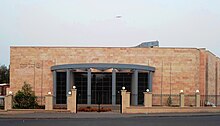
Foreign relations of Djibouti are managed by the Djiboutian Ministry of Foreign Affairs and International Cooperation. Djibouti maintains close ties with the governments ofSomalia,Ethiopia,Franceand theUnited States.It is likewise an active participant inAfrican Union,United Nations,Non-Aligned Movement,Organisation of Islamic CooperationandArab Leagueaffairs. Since the 2000s, Djiboutian authorities have also strengthened relations withTurkey.
Djibouti has been a member ofThe Forum of Small States (FOSS)since the group's founding in 1992.[82]
Military

TheDjiboutian Armed Forcesinclude the Djiboutian Army, which consists of the Djiboutian Navy, the Djiboutian Air Force, and the National Gendarmerie (GN). As of 2011[update],the manpower available for military service was 170,386 males and 221,411 females aged 16 to 49.[1]Djiboutispentover US$36 million annually on its military as of 2011[update](141st in theSIPRIdatabase). After independence, Djibouti had two regiments commanded by French officers. In the early 2000s, it looked outward for a model of army organization that would best advance defensive capabilities by restructuring forces into smaller, more mobile units instead of traditional divisions.
The first war to involve the Djiboutian Armed Forces was theDjiboutian Civil Warbetween the Djiboutian government, supported by France, and theFront for the Restoration of Unity and Democracy(FRUD). The war lasted from 1991 to 2001, although most of the hostilities ended when the moderate factions of FRUD signed a peace treaty with the government after suffering an extensive military setback when the government forces captured most of the rebel-held territory. A radical group continued to fight the government, but signed its own peace treaty in 2001. The war ended in a government victory, and FRUD became a political party.
As the headquarters of the IGAD regional body, Djibouti has been an active participant in the Somali peace process, hosting theArtaconference in 2000.[83]Following the establishment of theFederal Government of Somaliain 2012,[84]a Djiboutian delegation attended the inauguration ceremony of Somalia's new president.[85]
In recent years, Djibouti has improved its training techniques, military command and information structures and has taken steps to becoming more self-reliant in supplying its military to collaborate with the United Nations in peacekeeping missions, or to provide military help to countries that officially ask for it. Now deployed toSomaliaandSudan.[86]
Foreign military presence

TheFrench Forcesremained present in Djibouti when the territory gained independence, first as part of a provisional protocol of June 1977 laying down the conditions for the stationing of French forces, constituting a defense agreement. A new defence cooperation treaty betweenFranceand Djibouti was signed inParison 21 December 2011. It entered into force on 1 May 2014. By that treaty and its security clause, France reaffirmed its commitment to the independence andterritorial integrityof the Republic of Djibouti. As well before independence, in 1962, aFrench Foreign Legionunit, the13th Demi-Brigade of the Foreign Legion(13 DBLE) was transferred from Algeria to Djibouti to form the core of the French garrison there.[87]On 31 July 2011, the (13 DBLE) left Djibouti to theUnited Arab Emirates.
Djibouti's strategic location by theBab-el-MandebStrait, which separates theGulf of Adenfrom theRed Seaand controls the approaches to theSuez Canal,has made it a desirable location for foreign military bases.Camp Lemonnierwas abandoned by the French and later leased to theUnited States Central Commandin September 2002. The lease was renewed in 2014 for another 20 years.[88]The country also hosts the only overseasChinese support baseand the only overseasJapanese military base.[89]The Italian National Support Military Base is also located in Djibouti.[90]
The hosting of foreign military bases is an important part of Djibouti's economy. The United States pays $63 million a year to rent Camp Lemonnier,[89]France and Japan each pay about $30 million a year,[91]and China pays $20 million a year.[89]The lease payments added up to more than 5% of Djibouti's GDP ofUS$2.3 billionin 2017.[citation needed]
China has, in recent times, stepped up its military presence in Africa, with ongoing plans to secure an even greater military presence in Djibouti specifically. China's presence in Djibouti is tied to strategic ports to ensure the security of Chinese assets. Djibouti's strategic location makes the country prime for an increased military presence.[92]
Human rights
In its 2011 Freedom in the World report,Freedom Houseranked Djibouti as "Not Free", a downgrading from its former status as "Partly Free".
According to the 2019 U.S. State DepartmentCountry Report on Human Rights Practices,Djibouti's significant human rights issues include unlawful or arbitrary killings by government agents; arbitrary detention by government agents; harsh and life-threatening prison conditions; arbitrary or unlawful interference with privacy; unjustified arrests or prosecutions of journalists; criminal libel; substantial interference with the rights of peaceful assembly and freedom of association; significant acts of corruption; and violence against women and girls with inadequate government action for prosecution and accountability, including female genital mutilation/cutting. It states also that impunity was a problem, with the government seldom taking steps to identify and punish officials who committed abuses, whether in the security services or elsewhere in the government.[93]
Administrative divisions

Djibouti is partitioned into six administrative regions, withDjibouti cityrepresenting one of the official regions. It is further subdivided into twentydistricts.
| Region | Area (km2) | Population 2009 census |
Population 2018 estimate |
Capital |
|---|---|---|---|---|
| Ali Sabieh | 2,200 | 86,949 | 96,500 | Ali Sabieh |
| Arta | 1,800 | 42,380 | 72,200 | Arta |
| Dikhil | 7,200 | 88,948 | 105,300 | Dikhil |
| Djibouti | 200 | 475,322 | 603,900 | Djibouti City |
| Obock | 4,700 | 37,856 | 50,100 | Obock |
| Tadjourah | 7,100 | 86,704 | 121,000 | Tadjoura |
Geography
Location and habitat
Djibouti is in theHorn of Africa,on theGulf of Adenand theBab-el-Mandeb,at the southern entrance to theRed Sea.It lies between latitudes 11° and 14°N and longitudes 41° and 44°E, at the northernmost point of theGreat Rift Valley.It is in Djibouti that the rift between theAfrican Plateand theSomali Platemeets theArabian Plate,forming a geologic tripoint.[94]The tectonic interaction at this tripoint has created thelowest elevation of any place in AfricaatLake Assal,and the second-lowest depression on dry land anywhere on earth (surpassed only by the depression along the border of Jordan and Israel).
The country's coastline stretches 314 kilometres (195 miles), with terrain consisting mainly of plateau, plains and highlands. Djibouti has a total area of 23,200 square kilometres (8,958 sq mi). Its borders extend 575 km (357 mi), 125 km (78 mi) of which are shared withEritrea,390 km (242 mi) withEthiopia,and 60 km (37 mi) withSomaliland.[1]Djibouti is the southernmostcountry on the Arabian Plate.[95]
Djibouti has eight mountain ranges with peaks of over 1,000 metres (3,300 feet).[96]TheMousa Alirange is considered the country's highest mountain range, with the tallest peak on the border with Ethiopia and Eritrea. It has an elevation of 2,028 metres (6,654 feet).[96]TheGrand Baradesert covers parts of southern Djibouti in the Arta, Ali Sabieh and Dikhil regions. The majority of it sits at a relatively low elevation, below 1,700 feet (520 metres).
Extreme geographic points include: to the north, Ras Doumera and the point at which the border with Eritrea enters the Red Sea in the Obock Region; to the east, a section of the Red Sea coast north of Ras Bir; to the south, a location on the border with Ethiopia west of the town ofAs Ela;and to the west, a location on the frontier with Ethiopia immediately east of the Ethiopian town ofAfambo.
Most of Djibouti is part of theEthiopian xeric grasslands and shrublandsecoregion.The exception is an eastern strip along the Red Sea coast, which is part of theEritrean coastal desert.[97]
- Landscapes of Djibouti
-
Traditional houses on theMabla Mountains
-
The mountains nearDasbiyo
-
Beach south ofDjibouti City,overlooking theGulf of Aden
Climate

Djibouti'sclimateis significantly warmer and has significantly less seasonal variation than theworldaverage. The mean daily maximumtemperaturesrange from 32 to 41 °C (90 to 106 °F), except at high elevations. InDjibouti City,for instance, average afternoon highs range from 28 to 34 °C (82 to 93 °F) in April. But atAirolaf,which ranges from 1,535 to 1,600 m (5,036 to 5,249 ft), maximum temperature is 30 °C (86 °F) in summer and minimum 9 °C (48 °F) in winter.[98]In theuplandsranges from 500 to 800 m (1,600 to 2,600 ft), are comparable and cooler to those on thecoastin the hottest months of June until August. December and January is the coolest month with averages low temperatures falling as low as 15 °C (59 °F). Djibouti has either ahot semi-arid climate(BSh) or ahot desert climate(BWh), althoughtemperaturesare much moderated at the highestelevations.[98]
Djibouti's climate ranges fromaridin the northeastern coastal regions tosemi-aridin the central, northern, western and southern parts of the country. On the eastern seaboard, annual rainfall is less than 5 inches (130 mm); in the central highlands, precipitation is about 8 to 16 inches (200 to 410 millimetres). The hinterland is significantly lesshumidthan the coastal regions.
| Location | July (°C) | July (°F) | January (°C) | January (°F) |
|---|---|---|---|---|
| Djibouti City | 41/31 | 107/88 | 28/21 | 83/70 |
| Ali Sabieh | 36/25 | 96/77 | 26/15 | 79/60 |
| Tadjoura | 41/31 | 107/88 | 29/22 | 84/72 |
| Dikhil | 38/27 | 100/81 | 27/17 | 80/63 |
| Obock | 41/30 | 105/87 | 28/22 | 84/72 |
| Arta | 36/25 | 97/78 | 25/15 | 78/60 |
| Randa | 34/23 | 94/73 | 23/13 | 74/56 |
| Holhol | 38/28 | 101/81 | 26/17 | 79/62 |
| Ali Adde | 38/27 | 100/82 | 26/16 | 80/61 |
| Airolaf | 31/18 | 88/66 | 22/9 | 71/49 |
Wildlife

The country'sfloraandfaunalive in a harsh landscape with forest accounting for less than one percent of the total area of the country.[99]Wildlife is spread over three main regions, namely from the northern mountain region of the country to the volcanic plateaux in its southern and central part and culminating in the coastal region.
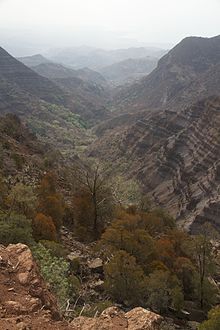
Most species of wildlife are found in the northern part of the country, in the ecosystem of theDay Forest National Park.At an average altitude of 1,500 metres (4,921 feet), the area includes the Goda massif, with a peak of 1,783 m (5,850 ft). It covers an area of 3.5 square kilometres (1 sq mi) ofJuniperus proceraforest, with many of the trees rising to 20 metres (66 feet) height. This forest area is the main habitat of the endangered and endemicDjibouti francolin(a bird), and another recently noted vertebrate,Platyceps afarensis(acolubrinesnake). It also contains many species of woody and herbaceous plants, including boxwood and olive trees, which account for 60% of the total identified species in the country.
According to the country profile related to biodiversity of wildlife in Djibouti, the nation contains more than 820 species of plants, 493 species of invertebrates, 455 species of fish, 40 species of reptiles, three species of amphibians, 360 species of birds and 66 species of mammals.[99]Wildlife of Djibouti is also listed as part ofHorn of Africabiodiversity hotspotand theRed SeaandGulf of Adencoral reefhotspot.[100]Mammals include several species of antelope, such as Soemmerring's gazelle and Pelzeln's gazelle. As a result of the hunting ban imposed since early 1970 these species are well conserved now. Other characteristic mammals areGrevy's zebra,hamadryas baboonandHunter's antelope.Thewarthog,a vulnerable species, is also found in the Day National park. The coastal waters have dugongs andAbyssinian genet;the latter needs confirmation by further studies.Green turtlesandhawksbill turtlesare in the coastal waters where nestling also takes place.[101][102]TheNortheast African cheetahAcinonyx jubatus soemmeringiiis thought to be extinct in Djibouti.
Economy
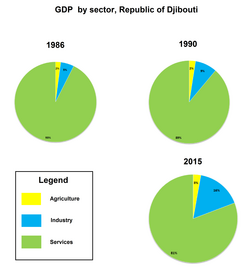
Djibouti's economy is largely concentrated in the service sector. Commercial activities revolve around the country's free trade policies and strategic location as a Red Sea transit point. Due to limited rainfall, vegetables and fruits are the principal production crops, and other food items require importation. The GDP (purchasing power parity) in 2013 was estimated at $2.505 billion, with a real growth rate of 5% annually. Per capita income is around $2,874 (PPP). The services sector constituted around 79.7% of the GDP, followed by industry at 17.3%, and agriculture at 3%.[1]
As of 2013[update],the container terminal at thePort of Djiboutihandles the bulk of the nation's trade. About 70% of the seaport's activity consists of imports to and exports from neighboringEthiopia,which depends on the harbour as its main maritime outlet.[103]As of 2018, 95% of Ethiopian transit cargo was handled by the Port of Djibouti.[104]The port also serves as an international refueling center and transshipment hub.[1]In 2012, the Djiboutian government in collaboration with DP World started construction of theDoraleh Container Terminal,[105]a third major seaport intended to further develop the national transit capacity.[1]A $396 million project, it has the capacity to accommodate 1.5 million twenty foot container units annually.[105]
Djibouti was ranked the 177th safest investment destination in the world in the March 2011 Euromoney Country Risk rankings.[106]To improve the environment for direct foreign investment, the Djibouti authorities in conjunction with various non-profit organizations have launched a number of development projects aimed at highlighting the country's commercial potential. The government has also introduced new private sector policies targeting high interest and inflation rates, including rela xing the tax burden on enterprises and allowing exemptions on consumption tax.[105] Additionally, efforts have been made to lower the estimated 60% urban unemployment rate by creating more job opportunities through investment in diversified sectors. Funds have especially gone toward building telecommunications infrastructure and increasing disposable income by supporting small businesses. Owing to its growth potential, the fishing and agro-processing sector, which represents around 15% of GDP, has also enjoyed rising investment since 2008.[105]
To expand the modest industrial sector, a 56 megawatt geothermal power plant slated to be completed by 2018 is being constructed with the help ofOPEC,theWorld Bankand theGlobal Environmental Facility.The facility is expected to solve the recurring electricity shortages, decrease the nation's reliance on Ethiopia for energy, reduce costly oil imports for diesel-generated electricity, and thereby buttress the GDP and lower debt.[105]
The Djibouti firm Salt Investment (SIS) began a large-scale operation to industrialize the plentiful salt in Djibouti'sLake Assalregion. Operating at an annual capacity of 4 million tons, the desalination project has lifted export revenues, created more job opportunities, and provided more fresh water for the area's residents.[1][105]In 2012, the Djibouti government also enlisted the services of the China Harbor Engineering Company Ltd for the construction of an ore terminal. Worth $64 million, the project enabled Djibouti to export a further 5,000 tons of salt per year to markets in Southeast Asia.[107]

Djibouti's gross domestic product expanded by an average of more than 6 percent per year, from US$341 million in 1985 to US$1.5 billion in 2015. TheDjiboutian francis the currency of Djibouti. It is issued by theCentral Bank of Djibouti,the country'smonetary authority.Since the Djiboutian franc is pegged to the U.S. dollar, it is generally stable and inflation is not a problem. This has contributed to the growing interest in investment in the country.[105][108][109]
As of 2010[update],10 conventional and Islamic banks operate in Djibouti. Most arrived within the past few years, including the Somali money transfer companyDahabshiiland BDCD, a subsidiary of Swiss Financial Investments. The banking system had previously been monopolized by two institutions: the Indo-Suez Bank and the Commercial and Industrial Bank (BCIMR).[108]To assure a robust credit and deposit sector, the government requires commercial banks to maintain 30% of shares in the financial institution;[clarification needed]a minimum of 300 million Djiboutian francs in up-front capital is mandatory for international banks. Lending has likewise been encouraged by the creation of a guarantee fund, which allows banks to issue loans to eligible small- and medium-sized businesses without first requiring a large deposit or other collateral.[105]
Saudi investors are also reportedly exploring the possibility of linking theHorn of Africawith theArabian Peninsulavia a 28.5-kilometre-long (17.7 mi)[110]oversea bridge through Djibouti, referred to as theBridge of the Horns.The investorTarek bin Ladenhas been linked to the project. In June 2010, Phase I of the project was delayed.[111]
Transport

TheDjibouti–Ambouli International AirportinDjibouti City,the country's only international airport, serves many intercontinental routes with scheduled and chartered flights.Air Djiboutiis the flag carrier of Djibouti and is the country's largest airline.
The new and electrifiedstandard gaugeAddis Ababa-Djibouti Railwaystarted operation in January 2018. Its main purpose is to facilitate freight services between the Ethiopian hinterland and the DjiboutianPort of Doraleh.
Car ferries pass theGulf of Tadjourafrom Djibouti City toTadjoura.There is thePort of Doralehwest of Djibouti City, which is the main port of Djibouti. The Port of Doraleh is the terminal of the new Addis Ababa–Djibouti Railway. In addition to the Port of Doraleh, which handles general cargo and oil imports, Djibouti (2018) has three other major ports for the import and export of bulk goods and livestock, thePort of Tadjourah(potash), theDamerjog Port(livestock) and thePort of Goubet(salt). Almost 95% of Ethiopia's imports and exports move through Djiboutian ports.[citation needed]
The Djiboutian highway system is named according to the road classification. Roads that are considered primary roads are those that are fully asphalted (throughout their entire length) and in general they carry traffic between all the major towns in Djibouti.
Djibouti is part of the21st Century Maritime Silk Roadthat runs from the Chinese coast to the Upper Adriatic region with its connections to Central and Eastern Europe.[112][113][114][115][116]
Media and telecommunications

Telecommunications in Djibouti fall under the authority of the Ministry of Communication.[117]
Djibouti Telecomis the sole provider of telecommunication services. It mostly utilizes a microwave radio relay network. A fiber-optic cable is installed in the capital, whereas rural areas are connected via wireless local loop radio systems. Mobile cellular coverage is primarily limited to the area in and around Djibouti city. As of 2015[update],23,000 telephone main lines and 312,000 mobile/cellular lines were in use. TheSEA-ME-WE 3submarine cableoperates toJeddah,Suez,Sicily,Marseille,Colombo,Singapore and beyond. Telephonesatelliteearth stations include 1Intelsat(Indian Ocean) and 1Arabsat.Medarabtel is the regional microwave radio relay telephone network.[1]
Radio Television of Djiboutiis the state-owned national broadcaster. It operates the sole terrestrial TV station, as well as the two domestic radio networks onAM1,FM2, and shortwave 0. Licensing and operation of broadcast media is regulated by the government.[1]Movie theaters include the Odeon Cinema in the capital.[118]
As of 2012[update],there were 215 local internet service providers. Internet users comprised around 99,000 individuals (2015). The internet country top-level domain is.dj.[1]
The main print newspapers are owned by the government: the French-language dailyLa Nation,the English weeklyDjibouti Post,and the Arabic weeklyAl-Qarn.There is also a statenews agency,Agence Djiboutienne d'Information. Non-government news websites are based abroad; for instance,La Voix de Djiboutioperates out of Belgium.[119]
Tourism
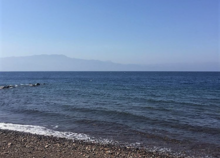
Tourism in Djibouti is one of the growing economic sectors of the country and is an industry that generates less than 80,000 arrivals per year, mostly the family and friends of the soldiers stationed in the country's major naval bases.[120]Although the numbers are on the rise, there are talks of the visa on arrival being stopped, which could limit tourism growth.
Infrastructure makes it difficult for tourists to travel independently and costs of private tours are high. Since the re-opening of the train line from Addis Ababa to Djibouti in January 2018,[121]travel by land has also resumed. Djibouti's two main geological marvels, Lake Abbe and Lake Assal, are the country's top tourist destinations. The two sites draw[122]hundreds of tourists every year looking for remote places that are not visited by many.
Energy
Djibouti has an installed electrical power generating capacity of 126 MW from fuel oil and diesel plants.[123]In 2002 electrical power output was put at 232 GWh, with consumption at 216 GWh. At 2015, per capita annual electricity consumption is about 330 kilowatt-hours (kWh); moreover, about 45% of the population does not have access to electricity,[123]and the level of unmet demand in the country's power sector is significant. Increasedhydropowerimports fromEthiopia,which satisfies 65% of Djibouti's demand, will play a significant role in boosting the country's renewable energy supply.[123]The geothermal potential has generated particular interest in Japan, with 13 potential sites; they have already started the construction on one site near Lake Assal. The construction of the photovoltaic power station (solar farms) in Grand Bara will generate 50 MW capacity.
Demographics
| Year | Pop. | ±% p.a. |
|---|---|---|
| 1950 | 62,001 | — |
| 1955 | 69,589 | +2.34% |
| 1960 | 83,636 | +3.75% |
| 1965 | 114,963 | +6.57% |
| 1970 | 159,659 | +6.79% |
| 1977 | 277,750 | +8.23% |
| 1980 | 358,960 | +8.93% |
| 1985 | 425,613 | +3.47% |
| 1990 | 590,398 | +6.76% |
| 1995 | 630,388 | +1.32% |
| 2000 | 717,584 | +2.62% |
| 2005 | 784,256 | +1.79% |
| 2010 | 850,146 | +1.63% |
| 2015 | 869,099 | +0.44% |
| 2018 | 884,017 | +0.57% |
| Source: World Bank[124] | ||
Djibouti has a population of about 921,804 inhabitants.[125][126]It is amultiethniccountry. The local population grew rapidly during the latter half of the 20th century, increasing from about 69,589 in 1955 to around 869,099 by 2015. The two largest ethnic groups native to Djibouti are theSomalis(60%) and theAfar(35%).[1]TheSomali clancomponent is mainly composed of theIssa,followed by theGadabuursiand theHabar Awalsub-clan of theIsaaq.[127]The remaining 5% of Djibouti's population primarily consists ofYemeni Arabs,EthiopiansandEuropeans(FrenchandItalians). Approximately 76% of local residents are urban dwellers; the remainder arepastoralists.[1]Djibouti also hosts a number of immigrants and refugees from neighboring states, with Djibouti City nicknamed the "French Hong Kong in the Red Sea" due to its cosmopolitan urbanism.[128]Djibouti's location on the eastern coast of Africa makes it a hub of regionalmigration,with Somalis, Yemenis, and Ethiopians traveling through the country en route to theGulfandnorthern Africa.Djibouti has received a massive influx of migrants fromYemen.[52][129]
Languages
Djibouti is amultilingualnation.[1]The majority of local residents speakSomali(524,000 speakers) andAfar(306,000 speakers) as first languages. They are themother tonguesof the Somali and Afar ethnic groups, respectively. Both languages belong to the largerAfroasiaticCushiticfamily.Northern Somaliis the main dialect spoken in the country and in neighbouring Somaliland, in contrast toBenadiri Somaliwhich is the main dialect spoken in Somalia.[131]There are two official languages in Djibouti:ArabicandFrench.[132]
Arabic is of religious importance. In formal settings, it consists ofModern Standard Arabic.Colloquially, about 59,000 local residents speak theTa'izzi-Adeni Arabicdialect, also known asDjibouti Arabic.French serves as a statutory national language. It was inherited from the colonial period, and is the primary language of instruction. Around 17,000 Djiboutians speak it as a first language. Immigrant languages includeOmani Arabic(38,900 speakers),Amharic(1,400 speakers), andGreek(1,000 speakers).[133]
Religion
Djibouti's population is predominantlyMuslim.Islamis observed by around 98% of the nation's population (approximately 891,000 as of 2022[update]).[134]As of 2012[update],94% of the population was Muslim whereas the remaining 6% of residents are Christian adherents.[1]
Islam entered the region very early on, as a group of persecuted Muslims had sought refuge across theRed Seain theHorn of Africaat the urging of the Islamic prophetMuhammad.In 1900, during the early part of the colonial era, there were virtually no Christians in the territories, with only about 100–300 followers coming from the schools and orphanages of the few Catholic missions in theFrench Somaliland.The Constitution of Djibouti names Islam as the solestate religion,and also provides for the equality of citizens of all faiths (Article 1) and freedom of religious practice (Article 11).[73][74]Most local Muslims adhere to theSunnidenomination, following theShafi'ischool. Thenon-denominational Muslimslargely belong toSufiorders of varying schools.[135]According to theInternational Religious Freedom Report2008, while Muslim Djiboutians have the legal right to convert to or marry someone from another faith, converts may encounter negative reactions from their family and clan or from society at large, and they often face pressure to go back to Islam.[136]
TheDiocese of Djiboutiserves the small localCatholicpopulation, which it estimates numbered around 7,000 individuals in 2006.[137]
Largest cities
| Rank | Name | Region | Pop. | ||||||
|---|---|---|---|---|---|---|---|---|---|
 Djibouti  Ali Sabieh |
1 | Djibouti | Djibouti | 475,322 |  Dikhil  Tadjoura | ||||
| 2 | Ali Sabieh | Ali Sabieh | 37,939 | ||||||
| 3 | Dikhil | Dikhil | 24,886 | ||||||
| 4 | Tadjoura | Tadjourah | 14,820 | ||||||
| 5 | Arta | Arta | 13,260 | ||||||
| 6 | Obock | Obock | 11,706 | ||||||
| 7 | Ali Adde | Ali Sabieh | 3,500 | ||||||
| 8 | Holhol | Ali Sabieh | 3,000 | ||||||
| 9 | Airolaf | Tadjourah | 1,023 | ||||||
| 10 | Randa | Tadjourah | 1,023 | ||||||
Health

Thelife expectancyat birth is around 64.7 for both males and females. Fertility is at 2.35 children per woman.[1]In Djibouti there are about 18 doctors per 100,000 persons.[139]
The 2010 maternal mortality rate per 100,000 births for Djibouti is 300. This is compared with 461.6 in 2008 and 606.5 in 1990. The under 5 mortality rate per 1,000 births is 95 and the neonatal mortality as a percentage of under 5's mortality are 37. In Djibouti the number of midwives per 1,000 live births is 6 and the lifetime risk of death for pregnant women 1 in 93.[140]
About 93.1% of Djibouti's women and girls have undergonefemale genital mutilation(FGM, sometimes referred to as 'female circumcision'),[141]a pre-marital custom mainly endemic to Northeast Africa and parts of the Near East.[142][143]Although legally proscribed in 1994, the procedure is still widely practiced, as it is deeply ingrained in the local culture.[144]Encouraged and performed by women in the community, FGM is primarily intended to deter promiscuity and to offer protection from assault.[144][145]About 94% of Djibouti's male population have also reportedly undergonemale circumcision,a figure in line with adherence to Islam; theShafi'i school of Islam,the predominantmadhhabin the Horn of Africa, requires circumcision of males and females.[146][147]
Education
Education is a priority for the government of Djibouti. As of 2009[update],it allocates 20.5% of its annual budget to scholastic instruction.[148]

The Djiboutian educational system was initially formulated to cater to a limited pupil base. As such, the schooling framework was largely elitist and drew considerably from the French colonial paradigm, which was ill-suited to local circumstances and needs.[148]
In the late 1990s, the Djiboutian authorities revised the national educational strategy and launched a broad-based consultative process involving administrative officials, teachers, parents, national assembly members and NGOs. The initiative identified areas in need of attention and produced concrete recommendations on how to go about improving them. The government subsequently prepared a comprehensive reform plan aimed at modernizing the educational sector over the 2000–10 period. In August 2000, it passed an official Education Planning Act and drafted a medium-term development plan for the next five years. The fundamental academic system was significantly restructured and made compulsory; it now consists of five years of primary school and four years of middle school. Secondary schools also require a Certificate of Fundamental Education for admission. In addition, the new law introduced secondary-level vocational instruction and established university facilities in the country.[148]
As a result of the Education Planning Act and the medium-term action strategy, substantial progress has been registered throughout the educational sector.[148]In particular, school enrollment, attendance, and retention rates have all steadily increased, with some regional variation. From 2004 to 2005 to 2007–08, net enrollments of girls in primary school rose by 18.6%; for boys, it increased 8.0%. Net enrollments in middle school over the same period rose by 72.4% for girls and 52.2% for boys. At the secondary level, the rate of increase in net enrollments was 49.8% for girls and 56.1% for boys.[149]
The Djiboutian government has especially focused on developing and improving institutional infrastructure and teaching materials, including constructing new classrooms and supplying textbooks. At the post-secondary level, emphasis has also been placed on producing qualified instructors and encouraging out-of-school youngsters to pursue vocational training.[148]As of 2012[update],the literacy rate in Djibouti was estimated at 70%.[150]
Institutions of higher learning in the country include theUniversity of Djibouti.
Culture

Djiboutian attire reflects the region's hot and arid climate. When not dressed in Western clothing such as jeans and T-shirts, men typically wear themacawiis,which is a traditionalsarong-like garment worn around the waist. Many nomadic people wear a loosely wrapped white cotton robe called atobethat goes down to about the knee, with the end thrown over the shoulder (much like a Romantoga).
Women typically wear thedirac,which is a long, light, diaphanousvoiledress made of cotton or polyester that is worn over a full-lengthhalf-slipand a bra. Married women tend to sport head-scarves referred to asshashand often cover their upper body with ashawlknown asgarbasaar.Unmarried or young women do not always cover their heads. Traditional Arabian garb such as the malejellabiya(jellabiyaadin Somali) and the femalejilbābis also commonly worn. For some occasions such as festivals, women may adorn themselves with specialized jewelry and head-dresses similar to those worn by theBerbertribes of theMaghreb.[151]
A lot of Djibouti's original art is passed on and preserved orally, mainly through song. Many examples of Islamic, Ottoman, and French influences can also be noted in the local buildings, which contain plasterwork, carefully constructedmotifs,andcalligraphy.
Music

Somalis have a rich musical heritage centered on traditional Somalifolklore.Most Somali songs arepentatonic.That is, they only use fivepitchesperoctavein contrast to aheptatonic(seven note) scale such as themajor scale.At first listen, Somali music might be mistaken for the sounds of nearby regions such as Ethiopia,Sudanor theArabian Peninsula,but it is ultimately recognizable by its own unique tunes and styles. Somali songs are usually the product of collaboration between lyricists (midho), songwriters (laxan) and singers (codkaor "voice" ).Balwois a Somali musical style centered on love themes that is popular in Djibouti.[152]
Traditional Afar music resembles the folk music of other parts of theHorn of Africasuch asEthiopia;it also contains elements ofArabic music.The history of Djibouti is recorded in the poetry and songs of its nomadic people, and goes back thousands of years to a time when the peoples of Djibouti traded hides and skins for the perfumes and spices of ancientEgypt,Indiaand China. Afar oral literature is also quite musical. It comes in many varieties, including songs for weddings, war, praise and boasting.[153]
Literature
Djibouti has a long tradition of poetry. Several well-developed Somali forms of verse include thegabay,jiifto,geeraar,wiglo,'buraanbur,beercade,afareyandguuraw.Thegabay(epic poem) has the most complex length and meter, often exceeding 100 lines. It is considered the mark of poetic attainment when a young poet is able to compose such verse, and is regarded as the height of poetry. Groups of memorizers and reciters (hafidayaal) traditionally propagated the well-developed art form. Poems revolve around several main themes, includingbaroorodiiq(elegy),amaan(praise),jacayl(romance),guhaadin(diatribe),digasho(gloating) andguubaabo(guidance). The baroorodiiq is composed to commemorate the death of a prominent poet or figure.[154]The Afar are familiar with theginnili,a kind of warrior-poet and diviner, and have a rich oral tradition of folk stories. They also have an extensive repertoire of battle songs.[155]
Additionally, Djibouti has a long tradition of Islamic literature. Among the most prominent historical works is the medievalFutuh Al-Habashby Shihāb al-Dīn, which chronicles theAdal Sultanatearmy'sconquest of Abyssiniaduring the 16th century.[156]In recent years, a number of politicians and intellectuals have also penned memoirs or reflections on the country.
Sport

Football is the most popular sport amongst Djiboutians. The country became a member ofFIFAin 1994, but has only taken part in the qualifying rounds for theAfrican Cup of Nationsas well as theFIFA World Cupin the mid-2000s. In November 2007, theDjibouti national football teambeatSomalia's national squad1–0 in the qualification rounds for the2010 FIFA World Cup,marking its first ever World Cup-related win.
Recently, theWorld Archery Federationhas helped to implement the Djibouti Archery Federation, and an international archery training center is being created inArtato support archery development in East Africa and Red Sea area.[citation needed]
Cuisine

Djiboutian cuisineis a mixture ofSomali,Afar,Yemeni,andFrench cuisine,with some additionalSouth Asian(especiallyIndian) culinary influences. Local dishes are commonly prepared using a lot of Middle Eastern spices, ranging fromsaffrontocinnamon.Grilled Yemeni fish, opened in half and often cooked in tandoori style ovens, are a local delicacy. Spicy dishes come in many variations, from the traditionalFah-fahor "Soupe Djiboutienne"(spicy boiled beef soup), to theyetakelt wet(spicy mixed vegetable stew).Xalwo(pronounced "halwo" ) orhalvais a popular confection eaten during festive occasions, such asEidcelebrations or wedding receptions. Halva is made from sugar,corn starch,cardamompowder,nutmegpowder andghee.Peanuts are sometimes added to enhance texture and flavor.[157]After meals, homes are traditionally perfumed usingincense(cuunsi) orfrankincense(lubaan), which is prepared inside an incense burner referred to as adabqaad.
See also
- Index of Djibouti-related articles
- Outline of Djibouti
- Religion in Djibouti
- Christianity in Djibouti
- Protestant Church of Djibouti
- Catholic Church in Djibouti
Notes
- ^/dʒɪˈbuːti/jih-BOO-tee;Arabic:جيبوتي,romanized:Jībūtī;French:Djibouti;Somali:Jabuuti;Afar:Yibuuti
- ^
- ^The Djiboutian–Somali border isde jurecontrolled by the internationally recognized Federal Republic of Somalia, but isde factounder the control of the unrecognizedRepublic of Somaliland.[9][10]
References
- ^abcdefghijklmnopqrstuvwx"Djibouti".The World Factbook.CIA. 5 February 2013.Archivedfrom the original on 9 January 2021.Retrieved26 February2013.
- ^"Democracy Index 2020".Economist Intelligence Unit.Archivedfrom the original on 3 March 2021.Retrieved17 December2021.
- ^"The world's enduring dictatorsArchived9 June 2013 at theWayback Machine".CBS News. May 16, 2011.
- ^Mastro, Oriana Skylar (3 March 2020). "All in the Family: North Korea and the Fate of Hereditary Autocratic Regimes".Survival.62(2): 103–124.doi:10.1080/00396338.2020.1739951.S2CID216340612.
- ^"Djibouti".The World Factbook(2024 ed.).Central Intelligence Agency.Retrieved22 June2023.
- ^abcd"World Economic Outlook Database, October 2023 Edition. (Djibouti)".IMF.org.International Monetary Fund.10 October 2023.Archivedfrom the original on 20 November 2023.Retrieved20 October2023.
- ^"Gini Index coefficient".CIA World Factbook.Archivedfrom the original on 17 July 2021.Retrieved12 August2021.
- ^"Human Development Report 2021/2022"(PDF).United Nations Development Programme.8 September 2022.Archived(PDF)from the original on 9 October 2022.Retrieved8 September2022.
- ^Mylonas, Harris."De Facto States Unbound – PONARS Eurasia".PONARS Eurasia.Archivedfrom the original on 14 October 2022.Retrieved8 April2022.
- ^Ker-Lindsay, James (2012).The foreign policy of counter secession: preventing the recognition of contested states(1st ed.). Oxford University Press. pp. 58–59.ISBN978-0-19-161197-1.OCLC811620848.
- ^abRaph Uwechue,Africa year book and who's who,(Africa Journal Ltd.: 1977), p. 209ISBN0903274051.
- ^Chisholm, Hugh,ed. (1911)..Encyclopædia Britannica.Vol. 25 (11th ed.). Cambridge University Press. p. 383.
- ^abcdA Political Chronology of Africa,(Taylor & Francis: 2001), p. 132ISBN1857431162.
- ^Chisholm, Hugh,ed. (1911)..Encyclopædia Britannica.Vol. 28 (11th ed.). Cambridge University Press. p. 950.
- ^"Today in Djibouti History".Historyorb.Archivedfrom the original on 16 May 2011.Retrieved27 April2011.
- ^"United Nations member states".United Nations.Archivedfrom the original on 30 December 2013.Retrieved27 April2011.
- ^Everett-Heath, John (22 May 2014). "Djibouti".The Concise Dictionary of World Place-Names (3 ed.).Oxford University Press.ISBN978-0-19-175139-4.Archivedfrom the original on 6 March 2019.Retrieved5 March2019.
{{cite book}}:|website=ignored (help) - ^Boujrada, Zineb (2 March 2018)."How Djibouti Got Its Unique Name".The Culture Trip.Archivedfrom the original on 6 March 2019.Retrieved4 March2019.
- ^"Countries Of The World That Are Named After Legendary Figures".Worldatlas.7 August 2018.Archivedfrom the original on 22 April 2020.Retrieved2 May2020.
- ^N.Y.), Metropolitan Museum of Art (New York (2008).Beyond Babylon: Art, Trade, and Diplomacy in the Second Millennium B.C.Metropolitan Museum of Art. p. 361.ISBN978-1-58839-295-4.
- ^Zarins, Juris (1990), "Early Pastoral Nomadism and the Settlement of Lower Mesopotamia", (Bulletin of the American Schools of Oriental Research)
- ^Diamond J, Bellwood P (2003) Farmers and Their Languages: The First Expansions SCIENCE 300,doi:10.1126/science.1078208
- ^Blench, R. (2006).Archaeology, Language, and the African Past.Rowman Altamira. pp. 143–144.ISBN978-0759104662.Archivedfrom the original on 14 September 2014.Retrieved8 September2014.
- ^Walter Raunig, Steffen Wenig (2005).Afrikas Horn.Otto Harrassowitz Verlag. p. 439.ISBN978-3447051750.Archivedfrom the original on 14 September 2014.Retrieved7 September2014.
- ^Connah, Graham (2004).Forgotten Africa: An Introduction to Its Archaeology.Routledge. p. 46.ISBN978-1134403035.Archivedfrom the original on 14 September 2014.Retrieved7 September2014.
- ^Universität Frankfurt am Main (2003).Journal of African Archaeology, Volumes 1–2.Africa Manga Verlag. p. 230.ISBN9783937248004.Archivedfrom the original on 14 September 2014.Retrieved7 September2014.
- ^Finneran, Niall (2013).The Archaeology of Ethiopia.Routledge. p. 86.ISBN978-1136755521.Archivedfrom the original on 29 December 2016.Retrieved29 December2016.
- ^Simson Najovits (2004)Egypt, Trunk of the Tree, Volume 2.Algora Publishing. p. 258.ISBN978-0875862569
- ^Joyce Tyldesley (1996)Hatchepsut: The Female Pharaoh.Penguin Books. p. 147.ISBN9780141929347
- ^Breasted, John Henry(1906–1907),Ancient Records of Egypt: Historical Documents from the Earliest Times to the Persian Conquest, collected, edited, and translated, with Commentary,vol. 1, University of Chicago Press, pp. 246–295
- ^abMohamed Haji Mukhtar,Historical Dictionary of Somalia,new edn, African Historical Dictionary Series, 87 (Lanham, MD: Scarecrow Press, 2003), s.v.Awdal[p. 44];ISBN0810843447
- ^Lewis, I. M. (1 January 1999).A Pastoral Democracy: A Study of Pastoralism and Politics Among the Northern Somali of the Horn of Africa.James Currey Publishers.ISBN9780852552803.Archivedfrom the original on 23 January 2023.Retrieved12 May2020.
- ^Shinn, David H.; Ofcansky, Thomas P. (11 April 2013).Historical Dictionary of Ethiopia.Scarecrow Press.ISBN9780810874572.
- ^Pieter, Esterhuysen (7 December 2013).Africa A to Z: Continental and Country Profiles: Third Edition.Africa Institute of South Africa.ISBN9780798303446.
- ^Briggs, Phillip (2012).Somaliland.Bradt Travel Guides. p. 7.ISBN978-1841623719.Archivedfrom the original on 12 October 2014.Retrieved21 December2016.
- ^"Image: The Travels of Al-Yaqubi".Image.prntsacr.Archived fromthe original(PNG)on 12 November 2021.Retrieved28 November2018.
- ^M. H. Mukhtar, 'Adal Sultanate', inThe Encyclopedia of Empire(Wiley, 2016),doi:10.1002/9781118455074.wbeoe145;ISBN9781118455074.
- ^Encyclopedia Americana, Volume 25.Americana Corporation. 1965. p. 255.Archivedfrom the original on 23 January 2023.Retrieved25 August2020.
- ^abLewis, I.M. (1955).Peoples of the Horn of Africa: Somali, Afar and Saho.International African Institute. p. 140.Archivedfrom the original on 18 May 2024.Retrieved21 December2016.
- ^"A Country Study: Somalia from The Library of Congress".Lcweb2.loc.gov.Archivedfrom the original on 9 January 2009.Retrieved27 April2011.
- ^Melton, J. Gordon and Baumann, Martin (2010)Religions of the World,Second Edition: A Comprehensive Encyclopedia of Beliefs and Practices. ABC-CLIO. p. 2663.ISBN1598842048.
- ^Jalata, Asafa (2004)State Crises, Globalisation, And National Movements in North-east Africa.Routledge. pp. 3–4.ISBN0415348102.
- ^Africanus, Leo (1526).The History and Description of Africa.Hakluyt Society. pp. 51–54.
- ^Northeast African Studies.Vol. 11. African Studies Center, Michigan State University. 1989. p. 115.Archivedfrom the original on 18 May 2024.Retrieved12 May2020.
- ^Houtsma, M. Th (1987).E.J. Brill's First Encyclopaedia of Islam, 1913–1936.BRILL. pp. 125–126.ISBN9004082654.Archivedfrom the original on 23 January 2023.Retrieved12 May2020.
- ^Lewis, I. M. (1999).A Pastoral Democracy: A Study of Pastoralism and Politics Among the Northern Somali of the Horn of Africa.James Currey Publishers. p. 17.ISBN0852552807.Archivedfrom the original on 23 January 2023.Retrieved12 May2020.
- ^Fattovich, Rodolfo (1987)."Some remarks on the origins of the Aksumite Stelae"(PDF).Annales d'Éthiopie.14(14): 43–69.doi:10.3406/ethio.1987.931.Archived fromthe original(PDF)on 24 September 2015.Retrieved7 September2014.
- ^"Tiya - Prehistoric site".UNESCO.Archivedfrom the original on 2 August 2022.Retrieved24 December2014.
- ^Fukui, Katsuyoshi (1997).Ethiopia in broader perspective: papers of the XIIIth International Conference of Ethiopian Studies Kyoto 12–17 December 1997.Shokado Book Sellers. p. 370.ISBN4879749761.Archivedfrom the original on 12 December 2015.Retrieved23 December2014.
- ^"FRENCH SOMALI COAST 1708 – 1946 FRENCH SOMALI COAST | Awdalpress".Archived fromthe originalon 9 June 2013.Retrieved19 April2013.FRENCH SOMALI COAST Timeline
- ^Henri, Brunschwig (1968)."Histoire Africaine".Cahiers d'Études africaines.8(29): 32–47.doi:10.3406/cea.1968.3123.Archivedfrom the original on 28 September 2022.Retrieved17 May2020.
- ^ab"Tracer des frontières à Djibouti".djibouti.frontafrique.org.Archivedfrom the original on 30 November 2022.Retrieved28 July2022.
- ^Adolphe, Martens; Challamel, Augustin; C, Luzac (1899).Le Regime de Protectorats.Bruxelles: Institut Colonial Internationale. p. 383.
- ^Simon, Imbert-Vier (2011).Trace des frontiere a Djibouti.Paris: Khartala. p. 128.
- ^Chisholm, Hugh,ed. (1911)..Encyclopædia Britannica.Vol. 25 (11th ed.). Cambridge University Press. p. 383.
- ^"Chisholm, Hugh,ed. (1911)..Encyclopædia Britannica.Vol. 15 (11th ed.). Cambridge University Press. p. 414.
- ^Chisholm, Hugh,ed. (1911)..Encyclopædia Britannica.Vol. 1 (11th ed.). Cambridge University Press. p. 86.
- ^"Chisholm, Hugh,ed. (1911)..Encyclopædia Britannica.Vol. 28 (11th ed.). Cambridge University Press. p. 950.
- ^Imbert-Vier 2008,pp. 226–29.
- ^Ebsworth 1953,p. 564.
- ^abcBarrington, Lowell (2006)After Independence: Making and Protecting the Nation in Postcolonial and Postcommunist StatesArchived5 September 2015 at theWayback Machine.University of Michigan Press.p. 115.ISBN0472068989
- ^Africa Research, Ltd (1966).Africa Research Bulletin, Volume 3.Blackwell. p. 597.Archivedfrom the original on 30 January 2015.Retrieved18 December2014.
- ^abcdNewsweek,Volume 81, (Newsweek: 1973), p.254.
- ^abAmerican Universities Field Staff (1968)Northeast Africa series,Volume 15, Issue 1, p. 3.
- ^abAlvin J. Cottrell, Robert Michael Burrell, Georgetown University. Center for Strategic and International Studies,The Indian Ocean: its political, economic, and military importance,(Praeger: 1972), p.166.
- ^"French Envoy in Somalia Held by Anti-Paris Group".The New York Times.25 March 1975.Archivedfrom the original on 2 July 2020.Retrieved20 May2020.
- ^Gonidec, Pierre François.African Politics.The Hague:Matinus Nijhoff, 1981. p. 272
- ^Légion-Étrangère.Légion-Étrangère. 2000. p. 2.Archivedfrom the original on 30 July 2017.Retrieved3 May2017.
- ^Kevin Shillington,Encyclopedia of African history,(CRC Press: 2005), p.360.
- ^Nohlen, D, Krennerich, M & Thibaut, B (1999)Elections in Africa: A data handbook,p. 322ISBN0-19-829645-2
- ^abClarke, Walter S. (1991)."The 'Esayi Dream: A Footnote to the Ogaden War".Northeast African Studies.13(1): 29–38.ISSN0740-9133.JSTOR43660335.
- ^"Djibouti President Guelleh wins election with 98%, provisional results".Africanews.n.d.Archivedfrom the original on 12 October 2022.Retrieved12 October2022.
- ^abcd"Djibouti's Constitution of 1992 with Amendments through 2010"(PDF).Constitute.Archived(PDF)from the original on 25 June 2016.Retrieved19 July2016.
- ^abcd"Constitution de la République de Djibouti"(in French). Agence Djiboutienne d'Information. Archived fromthe originalon 25 November 2012.Retrieved30 March2013.
- ^ab"Djibouti".Freedom House. 17 January 2012.Archivedfrom the original on 25 October 2012.Retrieved30 March2013.
- ^ab"DJIBOUTI: Guelleh sworn in for second presidential term".IRIN Africa. 9 May 2005.Archivedfrom the original on 29 November 2006.Retrieved20 March2013.
- ^ab"Djibouti validates presidential election".Middle East Online.13 April 2011.Archivedfrom the original on 2 June 2013.Retrieved30 March2013.
- ^"Sudan: President Al-Bashir Congratulates Djibouti President On His Re-Election".Sudan News Agency. 20 April 2011.Retrieved30 March2013.
- ^"Joint statement of the international observer missions of the Djibouti presidential elections held on April 08, 2011".Intergovernmental Authority on Development.10 April 2011.Archivedfrom the original on 16 June 2013.Retrieved30 March2013.
In view of the foregoing, the international mission found that the election of 8 April 2011 was peaceful, calm, fair, transparent and took place in dignity. It declares that the election was free and democratic.
- ^"M. Abdoulkader Kamil Mohamed, grand commis de l'Etat et nouveau Premier ministre djiboutien".Adjib. Archived fromthe originalon 1 January 2014.Retrieved1 April2013.
- ^"Djibouti government reaches deal to bring opposition into parliament".Goobjoog.30 December 2014.Archivedfrom the original on 1 January 2015.Retrieved1 January2015.
- ^50 Years of Singapore and the United Nations.World Scientific. 2015.ISBN978-981-4713-03-0.access-date=28 March 2024
- ^The Rise and Fall of the Somalia Airforce: A Diary ReflectionArchived26 February 2014 at theWayback Machine
- ^"Somalia: UN Envoy Says Inauguration of New Parliament in Somalia 'Historic Moment'".Forum on China-Africa Cooperation.21 August 2012.Archivedfrom the original on 14 October 2012.Retrieved24 August2012.
- ^Mohamed, Mahmoud (17 September 2012)."Presidential inauguration ushers in new era for Somalia".Sabahi.Archivedfrom the original on 22 October 2012.Retrieved30 September2012.
- ^Murithi, Tim (1993).Handbook of Africa's International Relations.Routledge. p. 98.ISBN978-1136636967.Archivedfrom the original on 11 October 2017.Retrieved24 September2016.
- ^Anthony Clayton, 'France, Soldiers, and Africa,' Brassey's, 1988, 388.
- ^"Djibouti Is Hot".Bloomberg.Archivedfrom the original on 4 October 2017.Retrieved19 September2017.
- ^abcJacobs, Andrew; Perlez, Jane (25 February 2017)."U.S. Wary of Its New Neighbor in Djibouti: A Chinese Naval Base".The New York Times.Archivedfrom the original on 14 May 2017.Retrieved17 May2017.
- ^"Djibouti, Foreign Military Bases on the Horn of Africa; Who is there? What are they up to?".2 January 2019.Archivedfrom the original on 17 May 2019.Retrieved17 May2019.
- ^Styan, David (April 2013)."Djibouti: Changing Influence in the Horn's Strategic Hub".Chatham House.Archived(PDF)from the original on 26 November 2013.Retrieved15 August2018.
- ^Chandran, Nyshka (27 June 2018)."China increases defense ties with Africa".cnbc.Archivedfrom the original on 16 December 2018.Retrieved14 December2018.
- ^State, US Department of (11 March 2020)."Country Report on Human Rights Practices 2019 – Djibouti".state.gov.Archivedfrom the original on 13 April 2021.Retrieved19 March2021.
- ^Manighetti, Isabelle; Tapponnier, Paul; Courtillot, Vincent; Gruszow, Sylvie; Gillot, Pierre-Yves (1997)."Propagation of rifting along the Arabia-Somalia plate boundary: The gulfs of Aden and Tadjoura".Journal of Geophysical Research: Solid Earth.102(B2): 2681–2710.Bibcode:1997JGR...102.2681M.doi:10.1029/96JB01185.
- ^Geothermal Resources Council (1985).1985 International Symposium on Geothermal Energy, Volume 9, Part 1.p. 175.
- ^abHighest Mountains in DjiboutiArchived16 October 2013 at theWayback Machine.geonames.org
- ^"Eritrean coastal desert".Terrestrial Ecoregions.World Wildlife Fund.
- ^ab"Weatherbase: Djibouti".Archivedfrom the original on 5 September 2015.Retrieved1 July2015.
- ^ab"Le Pèlerin du Day".World Food Programme. Archived fromthe originalon 20 March 2012.Retrieved27 February2013.
- ^"Djibouti".Living National Treasures.Archivedfrom the original on 3 August 2013.Retrieved27 February2013.
- ^International Union for Conservation of Nature and Natural Resources; Norway. Direktoratet for utviklingshjelp (1989).The IUCN Sahel studies 1989.IUCN. pp. 95, 104.ISBN978-2-88032-977-8.Archivedfrom the original on 1 January 2014.Retrieved28 May2011.
- ^S. N. Stuart; Richard J. Adams (1990).Biodiversity in Sub-Saharan Africa and its Islands: Conservation, Management and Sustainable Use.IUCN. pp.81–82.ISBN978-2-8317-0021-2.Retrieved28 May2011.
- ^"Ethiopia signs Djibouti railway deal with China".Reuters.17 December 2011.Archivedfrom the original on 8 February 2021.Retrieved11 December2019.
- ^Port Development and Competition in East and Southern Africa: Prospects and challenges(PDF).Transport Global Practice. Vol. 2: Country and Port Fact Sheets and Projections. World Bank Group. 2018. p. 9.Archived(PDF)from the original on 12 December 2019.
- ^abcdefghBansal, Ridhima (23 September 2011)."Current Development Projects and Future Opportunities in Djibouti".Association of African Entrepreneurs. Archived fromthe originalon 27 March 2013.Retrieved26 February2013.
- ^"Euromoney Country Risk".Euromoney Institutional Investor PLC.Archivedfrom the original on 30 July 2011.Retrieved15 August2011.
- ^"Djibouti, China Sign 64 mln USD Agreement to Facilitate Salt Export".Xinhua News Agency. 20 November 2012. Archived fromthe originalon 24 February 2014.Retrieved27 February2013.
- ^ab"Djibouti banking boom attracts foreign investors".Reuters. 23 March 2010.Archivedfrom the original on 26 May 2013.Retrieved27 February2013.
- ^Le système informel de transferts de fonds et le mécanisme automatique du Currency Board: complémentarité ou antagonisme? Le cas des transferts des hawalas à DjiboutiArchived24 February 2014 at theWayback Machine.univ-orleans.fr
- ^"Bridge of the Horns, Cities of Light: Will They Ever Actually Be Built?".The Basement Geographer.WordPress. 27 June 2011. Archived fromthe originalon 28 August 2013.Retrieved1 September2015.
- ^"Phase I of Yemen and Djibouti Causeway delayed".Steelguru. 22 June 2010.Archivedfrom the original on 5 April 2016.Retrieved24 March2016.
- ^"Africa News: The China Merchants in Djibouti: from the maritime to the digital silk roads (by Thierry Pairault)".Archived fromthe originalon 15 January 2021.Retrieved20 January2021.
- ^Harry G. Broadman "Afrika's Silk Road" (2007), pp 59.
- ^Marcus Hernig: Die Renaissance der Seidenstraße (2018) pp 112.
- ^Diego Pautasso "The role of Africa in the New Maritime Silk Road" In: Brazilian Journal of African Studies, v.1, n.2, Jul./Dec. 2016 | p.118-130.
- ^David Styan "Djibouti and Small State Agency in the Maritime Silk Road: The Domestic and International Foundations" (2020).
- ^"Chiefs of State and Cabinet Members of Foreign Governments".CIA. Archived fromthe originalon 21 December 2016.Retrieved23 November2016.
- ^"Movie theaters in Djibouti, Djibouti".Cinema Treasures.Archivedfrom the original on 24 November 2016.Retrieved24 November2016.
- ^"Djibouti media guide".BBC News.20 December 2022.Archivedfrom the original on 3 March 2023.Retrieved3 March2023.
- ^"African Nation of Djibouti banks on Chinese tourists".South China Morning Post.17 April 2017.Archivedfrom the original on 14 March 2018.
- ^"Ethiosport launch of the train to Djibouti".ethiosports.1 January 2018.Archivedfrom the original on 14 March 2018.Retrieved14 March2018.
- ^"Things to do in Djibouti".onceinalifetimejourney.14 March 2018.Archivedfrom the original on 14 March 2018.Retrieved14 March2018.
- ^abc"Diversification key to expansion of Djibouti's energy sector".Oxford Business Group.16 March 2016.Archivedfrom the original on 3 November 2017.Retrieved25 February2018.
- ^"Djibouti Population".World Bank.Archivedfrom the original on 26 October 2015.Retrieved26 October2015.
- ^"World Population Prospects 2022".United Nations Department of Economic and Social Affairs,Population Division.Retrieved17 July2022.
- ^"World Population Prospects 2022: Demographic indicators by region, subregion and country, annually for 1950-2100"(XSLX)( "Total Population, as of 1 July (thousands)" ).United Nations Department of Economic and Social Affairs,Population Division.Retrieved17 July2022.
- ^Refugees, United Nations High Commissioner for."Refworld | Somalia: Information on the Issa and the Issaq".Refworld.Archivedfrom the original on 16 February 2023.Retrieved10 October2021.
- ^Anglin, Kevin; Blond, Becca and Carillet, Jean-Bernard (2004)Africa on a Shoestring.London: Lonely Planet. p. 698.ISBN978-1740594622
- ^DIRECTORATE OF INTELLIGENCE, INTELLIGENCE MEMORANDUM (1967)."French Somaliland"(PDF).Intelligence Memorandum.Archived fromthe original(PDF)on 23 January 2017.
- ^USA (9 August 2012)."Religious Identity Among Muslims | Pew Research Center".Pewforum.org.Archivedfrom the original on 26 December 2016.Retrieved24 May2020.
- ^Blench, Roger (2006)."The Afro-Asiatic Languages: Classification and Reference List"(PDF).p. 3.Archived(PDF)from the original on 7 October 2013.Retrieved25 April2021.
- ^Cutbill, Catherine C.; Schraeder, Peter J. (22 August 2019)."Djibouti: Language".Encyclopædia Britannica.Archivedfrom the original on 9 February 2023.Retrieved18 December2020.
- ^"Djibouti – Languages".Ethnologue.Archivedfrom the original on 10 September 2016.Retrieved6 September2016.
- ^"Islamic World".Nations Online.Archivedfrom the original on 3 April 2022.Retrieved20 March2022.
- ^Chapter 1: Religious AffiliationArchived26 December 2016 at theWayback Machine.Retrieved 4 September 2013
- ^United Nations High Commissioner for Refugees."Immigration and Refugee Board of Canada," Djibouti: Situation and treatment of Christians, including instances of discrimination or violence; effectiveness of recourse available in cases of mistreatment; problems that a Muslim can face if he or she converts to Christianity or marries a Christian (2000–2009) ", 5 August 2009".Unhcr.org.Archivedfrom the original on 10 May 2011.Retrieved20 June2010.
- ^Cheney, David M."Diocese of Djibouti".Catholic-hierarchy.org.Archivedfrom the original on 12 March 2013.Retrieved28 February2013.
- ^"Djibouti: Regions, Major Cities & Towns – Population Statistics, Maps, Charts, Weather and Web Information".citypopulation.de.Archivedfrom the original on 16 November 2021.Retrieved8 December2021.
- ^"Republic of Djibouti: Humanitarian Country Profile".IRIN. February 2007. Archived fromthe originalon 17 February 2010.Retrieved20 June2010.
- ^"The State of the World's Midwifery".United Nations Population Fund.Archivedfrom the original on 19 June 2011.Retrieved1 August2011.
- ^"Prevalence of FGM".Who.int. 9 December 2010. Archived fromthe originalon 23 April 2011.Retrieved27 April2011.
- ^Hayes, Rose Oldfield (1975)."Female genital mutilation, fertility control, women's roles, and the patrilineage in modern Sudan: a functional analysis".American Ethnologist.2(4): 617–633.doi:10.1525/ae.1975.2.4.02a00030.
- ^Bodman, Herbert L. and Tohidi, Nayereh Esfahlani (1998)Women in Muslim societies: diversity within unityArchived5 September 2015 at theWayback Machine.Lynne Rienner Publishers. p. 41.ISBN1555875785.
- ^ab"DJIBOUTI: Women fight mutilation".IRIN. 12 July 2005.Archivedfrom the original on 16 May 2011.Retrieved27 April2011.
- ^Suzanne G. Frayser, Thomas J. Whitby,Studies in human sexuality: a selected guideArchived5 September 2015 at theWayback Machine,(Libraries Unlimited: 1995), p. 257ISBN1563081318.
- ^Eric Werker; Amrita Ahuja; Brian Wendell."Male Circumcision and AIDS: The Macroeconomic Impact of a Health Crisis"(PDF).NEUDC 2007 Papers:: Northeast Universities Development Consortium Conference: Center for International Development at Harvard Un.Archived(PDF)from the original on 19 July 2011.Retrieved27 April2011.
- ^Kueny, Kathryn (2004)."Abraham's Test: Islamic Male Circumcision as Anti/Ante-Covenantal Practice".In Reeves, John C. (ed.).Bible and Qurʼān: Essays in Scriptural Intertextuality.Symposium Series (Society of Biblical Literature).Vol. 24.Leiden:Brill Publishers.pp. 161–173.ISBN90-04-12726-7.ISSN1569-3627.Archivedfrom the original on 30 September 2021.Retrieved6 February2020.
- ^abcdeHare, Harry (2007)ICT in Education in DjiboutiArchived16 December 2009 at theWayback Machine,World Bank
- ^Djibouti Assistance to Education EvaluationArchived12 November 2012 at theWayback Machine.USAID (April 2009)
- ^Compact Atlas of the World.Penguin. 2012. p. 138.ISBN978-0756698591.Archivedfrom the original on 11 October 2014.Retrieved20 February2016.
- ^"Image of Djibouti women in head-dresses".discoverfrance.net.Archivedfrom the original on 14 June 2007.Retrieved31 May2007.
- ^Abdullahi, Mohamed Diriye (2001)Culture and Customs of Somalia.Greenwood Press. pp. 170–172.ISBN9780313313332
- ^"Djibouti – Culture Overview".Expedition Earth.Archived fromthe originalon 27 February 2004.Retrieved28 September2005.–Website no longer exists; link is toInternet Archive
- ^Abdullahi, Mohamed Diriye (2001)Culture and Customs of Somalia,Greenwood Press. pp. 75–76.ISBN9780313313332
- ^Phillips, Matt and Carillet, Jean-Bernard (2006)Lonely Planet Ethiopia and Eritrea,Lonely Planet. p. 301.ISBN9781741044362
- ^Shihāb al-Dīn Aḥmad ibn ʻAbd al-Qādir ʻArabfaqīh (2003).The conquest of Abyssinia: 16th century.Translated by Paul Stenhouse; Richard Pankhurst. Tsehai Publishers & Distributors. p. 77.ISBN9780972317269.Archivedfrom the original on 5 September 2015.Retrieved20 June2015.
- ^Ali, Barlin (2007)Somali Cuisine.AuthorHouse. p. 79.ISBN9781425977061
Sources
 This article incorporatespublic domain materialfromThe World Factbook(2024 ed.).CIA.(Archived 2016 edition.)
This article incorporatespublic domain materialfromThe World Factbook(2024 ed.).CIA.(Archived 2016 edition.)- Ebsworth, W. A. (1953). "Jibouti and Madagascar in the 1939–45 War".Journal of the Royal United Service Institution.98(592): 564–68.doi:10.1080/03071845309422199.
- Imbert-Vier, Simon (2008).Frontières et limites à Djibouti durant la période coloniale (1884–1977)(PhD thesis).Université de Provence–Aix-Marseille I.
External links
- Government
- "Site Officiel de la République de Djibouti"[Official website of the Republic of Djibouti] (in French). Government of Djibouti.
- "Office National de Tourisme de Djibouti".National Official of Tourism of Djibouti. Archived fromthe originalon 24 December 2018.Retrieved28 February2013.
- Profile
- Djibouti.The World Factbook.Central Intelligence Agency.
- Djibouti profilefrom theBBC News.
- Djiboutiweb resources provided by GovPubs at theUniversity of Colorado Boulder Libraries
- DjiboutiatCurlie
- Others
- Djibouti
- 1977 establishments in Djibouti
- Countries and territories where Arabic is an official language
- Countries in Africa
- East African countries
- Former French colonies
- French-speaking countries and territories
- Gulf of Aden
- Horn African countries
- Least developed countries
- Member states of the Organisation internationale de la Francophonie
- Member states of the African Union
- Member states of the Arab League
- Member states of the Organisation of Islamic Cooperation
- Member states of the United Nations
- Republics
- Countries and territories where Somali is an official language
- States and territories established in 1977



